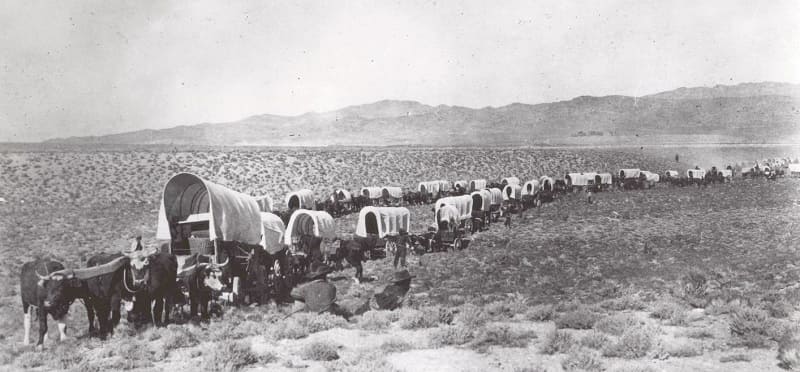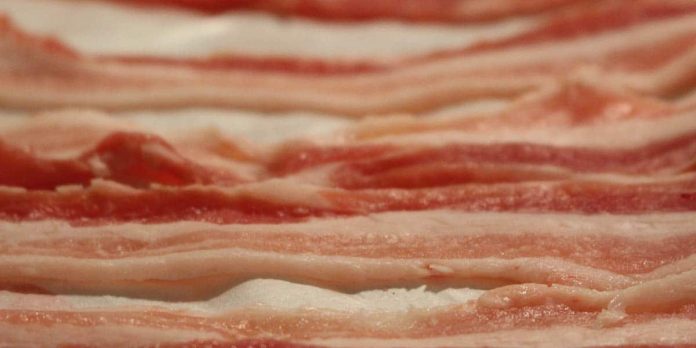When we talk about the pioneers, it is usually as people who sought out a better life to exercise their religion in freedom.
In focusing on their pursuit of freedom, we often gloss over the fact that the early pioneers were incredibly brave…
And also incredibly self-sufficient.

There were hardly any stores along the Oregon Trail (or the numerous other pioneer trails) where they could pick up provisions. They had to know how to forage their own food and cook meals out of practically nothing.
Even once they were settled, the pioneers still had to be resilient. A single storm could take out half a year’s of food supplies. There wasn’t any refrigeration, and even canning didn’t become common until later (which, of course, you’d need access to jars to do!).
I find all aspects of pioneer life fascinating: how they organized labor, handled medicine, built their homes…
But how the pioneers ate is one of the most interesting aspects of their life. It gives you insight into how creative and hard-working they were in their endeavors to sustain their families in challenging situations.
Below are some foods the pioneers ate – and what we might be eating again if a disaster strikes.
Common Pioneer Foods
- Bread: The pioneers didn’t have packages of yeast. They usually made their bread with the “salt-rising” method. The bread dough was mixed in a kettle while they were traveling. Natural bacteria in the dough would cause it to rise. Then the dough was baked in the kettle over a campfire at night. Read more about it here. (Amazon link)
- Cured Meat: Without refrigerators, meat was preserved either by smoke or salt curing. To salt cure meat, salt was rubbed into the meat. The meat was then covered with salt for about 1 month, during which time more salt was continuously added. Bacon was a particular favorite of the pioneers. More about food preservation here.
- Cornmeal, dried corn: The pioneers brought along dried corn and would grind it into meal to make cakes and breads. See, does cornmeal go bad?
- Lard: Forget fancy olive oil! The pioneers used fat from animals to cook their food. It was a staple on the trail. How to store lard long term.
- Eggs: Pioneers on the Oregon Trail did bring chickens along in crates tied to the backs of their wagons. However, it is doubtful that they laid eggs in the bumpy, stressful conditions. Eggs were mostly used in pioneer recipes once they got settled.
- Rabbits, squirrels, and small game: These could be easily hunted along the way. See our guide to eating squirrel
- Squash: Squash, such as pumpkins, doesn’t spoil quickly and can grow in the wild. The pioneers would make mashes and cakes out of them.
- Dried fruit: To dry fruit, pioneers would lay the sliced fruit out in the sun.
- Tubers (potatoes, turnips, etc.): These were also a pioneer favorite because they lasted a long time without spoiling. Tubers could also be foraged easily on the frontier.
Pioneer Recipes
Here are some authentic pioneer recipes. Not all of them are bad, so give ’em a try!
Note that most pioneer recipes are made with ingredients that have long shelf lives.
If you are worried about disaster preparedness and what you’d eat during a hurricane, earthquake, or other SHTF situation, check out our eBook on How to Build a 30 Day Emergency Food Supply. You can buy it now for $7.
Hardtack
Also called “sea biscuit,” hardtack (Amazon link) was eaten by pioneers, sailors, and soldiers during war. It is made of flour and water, mixed and baked for a long time in an oven. During bad times, the pioneers often had nothing to eat, but hardtack dipped into coffee.
Recommended Reading: How to Make Hardtack
Hoecake
Pioneers brought along dried corn because it didn’t spoil. They could grind it into meal to make biscuits or “cakes.” For hoecake, mix the following ingredients and fry on a skillet:
- 2 cups cornmeal
- 1 cup water or milk
- ½ tsp baking powder
- ½ tsp salt
- 1 tbsp shortening
Pocket Yams
First, make a campfire. Once you’ve got enough coals, you can bake the yams (or potatoes). Cover the yams with the coals and let them bake until steam comes out – about 40 minutes. Note that the yams shouldn’t be in the flames, just in the hot coals.
When the yams are done, DO NOT EAT THEM.
These yams are meant to go into your pocket to warm up your hands! This is another cool way pioneer mothers kept their families warm during the cold months.
Cooked Cabbage Salad
This recipe probably comes from German pioneers who particularly loved cabbage dishes. Make in a skillet:
- 1 pint of chopped cabbage
- 1 egg, beaten
- ¼ cup vinegar
- 1 tsp butter
- Salt and pepper
The pioneers might add sugar and a ½ cup of fresh cream to the cabbage if they had it.
Mormon Gravy
Gravy was slathered on top of vegetable pies, bread, or potatoes. It added much-needed flavor and moisture to the bland, dry food. To make it:
- Heat skillet with 3-4 tbsp of meat drippings (Amazon link)
- Add 3 tbsp of flour; stir constantly while browning the flour
- Remove from heat and add 2 cups of milk; stir
- Return to heat, stir constantly until mixture is smooth and thick
- Season with salt and pepper
Bread Pudding
The pioneers didn’t waste anything. So, they used stale bread to make bread pudding.
- 2 cups cubed stale bread
- 2 cups milk
- ¼ cup sugar
- 3 tbsp butter or lard
- 2 eggs
- Salt
Put bread in a baking dish. In a saucepan, mix milk, sugar, and butter. Remove from heat and whisk in eggs. Pour the mixture over the bread. Make at 350 degrees for 40 minutes.
Thrift Fritters
The pioneers didn’t always know what foods they’d find. For example, they might return from a foraging trip with a few wild carrots, nettles, and wild onions. These random veggies could be added to old mashed potatoes, a beaten egg, and maybe some flour. Form them into patties and fry them in drippings to make a fritter.
Butterless, Eggless, Milkless Cake
This sounds like a recipe for a health-food cake, but it is really a pioneer classic!
- 1 cup brown sugar
- 1 cup cold water
- 1 1/2 cup raisins
- 1/3 cup shortening
- 1 tsp cinnamon
- 1/4 tsp nutmeg
- 1/2 tsp cloves
- 1/2 tsp salt
- 1 tsp baking soda dissolved in 2 tbsp of hot water
- 2 cups flour
- ½ tsp baking powder
To make, boil the first 8 ingredients (sugar through salt) together for a couple minutes. Then add the baking soda, flour, and baking powder. Bake in a flat pan at 350 degrees for 40 minutes.
Tender Meat
The pioneers brought along cattle for milk and sometimes would butcher them. They didn’t exactly have the most tender meat! Other game wasn’t exactly tender either.
To tenderize the meat, they used this recipe:
- Mix 1 cup of fine breadcrumbs with some salt, pepper, thyme, or other herbs
- Add enough milk to make a very thick dressing
- Spread dressing over meat.
- Roll up the meat and tie it with twine.
- Brown the meat in fat.
- Add ½ pint of water. Cover and cook until the meat is tender.
Corn Soup
Dried corn was a staple of the pioneers. They made all sorts of things out of it, including soup.
The pioneer women would add whatever they had to the soup. For example, they might boil together the dried corn with wild greens, potatoes, parsley, peppers, beans, eggs, and rice to make a hearty soup.
Bacon and Sourdough Pancakes
This one sounds good, right? It wouldn’t exactly pass modern health inspections, though, because the sourdough starter was made by leaving flour + water out for days. The bacteria in the air would cause it to ferment.
You can read more about how to make sourdough here. (Amazon link)
What do you think you’ll be cooking if a disaster hits and wipes out the grid?










